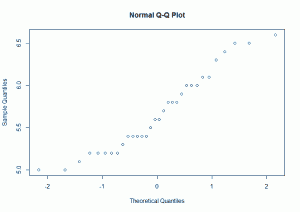Here’s your next reading assignment. Read Sections 3.2 and 3.4 in your textbook and answer the following questions by 8 a.m., Monday, February 13th. Be sure to login (using the link near the bottom of the sidebar) to the blog before leaving your answers in the comment section below.
- Consider the normal probability plot seen below. Looking at the plot, would you say that the data come from a normally distributed population? If not, how would the histogram for these data vary from that of a normal histogram? (You can click on the image below to see a larger version.)
- Consider the following experiment: On a Friday night, a highway patrol officer sets up a roadblock and stops 100 drivers. A given driver is considered a success if he or she is wearing a seat belt; the driver is considered a failure otherwise. Can we consider this experiment a binomial experiment? Why or why not?
- What’s one question you have about the reading?

